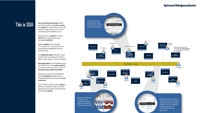Service-oriented architectures gain traction

Taking cues from banks, health care institutions and other large IT-centric organizations that intelligently handle thousands of digital files, several media organizations are discussing ways to implement new types of file management systems that enable content owners to leverage new distribution platforms in the most efficient and cost-effective way. As broadcasters convert to file-based infrastructures, sophisticated software platforms that sit on top of existing system designs are required to realize the full benefits of digital operations and the flexibility it offers.
National TeleConsultants (NTC), a media-facility design, engineering and systems-integration company, has embarked on a new initiative designed to help broadcasters and other media companies develop service-oriented architectures (SOA) and business process management (BPM) strategies. They’ve developed a schematic design called a Media Enterprise Technology Architecture that addresses the media industry specifically. It’s designed to tie together all of the different proprietary software systems (e.g. asset management islands) already running in many media organizations.
John Footen, director of software systems engineering at NTC, said his company has come to understand that the technology to implement such a system is now available. The challenge is figuring out how a company’s existing workflow can be improved upon with the technology so digital assets are logged, tracked, processed and distributed across a large enterprise in the most effective way. SOAs and BPM topologies represent a way for broadcasters to get a better handle on the content they own and how best to repurpose it to the best financial and competitive advantage.
An SOA is a “design methodology for application integration” and not a specific technology or product, Footen said. It addresses how a media enterprise — such as a broadcast station or network — can take multiple software applications from different vendors and get them to communicate with one another. The key is to do so in a way that gives users better control over the process.
In the past, broadcast workflows have always been tightly coupled with specific technologies (edit systems, graphics generators, station automation, etc.), according to Footen. An SOA eliminates the point-to-point, tightly coupled, “accidental” architectures that naturally resulted when separate new systems were added over time. Now that the broadcast industry is transitioning to file-based workflows, SOA’s have become more valuable.
In a broadcast facility’s SOA, every application — whether it’s asset management, editing, ingest or even HR or accounting — is tightly integrated and defined as a service or task that connects to a messaging bus, often called middleware. Once connected, media businesses can then control how those services operate together in a cohesive workflow. Middleware technologies use an orchestration engine to determine all of the activity between people and software. This provides benefits to a number of specific tasks, such as producing a daily newscast or programming multiple channels for satellite or cable distribution.
BPM, on the other hand, is a set of best practices around how enterprise architectures such as SOA are leveraged to enable formalized business processes that simplify, automate and optimize operations to best serve clients, obtain improved results and lower costs.
The professional video industry's #1 source for news, trends and product and tech information. Sign up below.
For years, NTC has used BPM models to define, collect and analyze business metrics, and offered advice on how to use that information to simplify and optimize workflows.
In offering SOAs and BPM strategies to its clients, Footen said that NTC was not building a particular application, but instead helping broadcasters to establish custom environments that work seamlessly with new and existing tools from a variety of vendors.
For more information, visit www.ntc.com.
